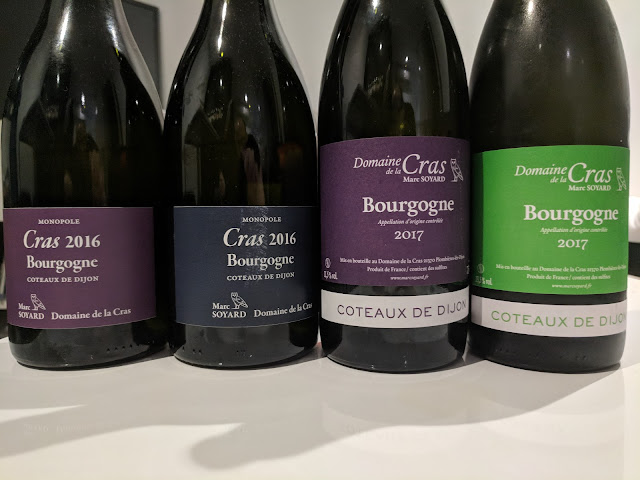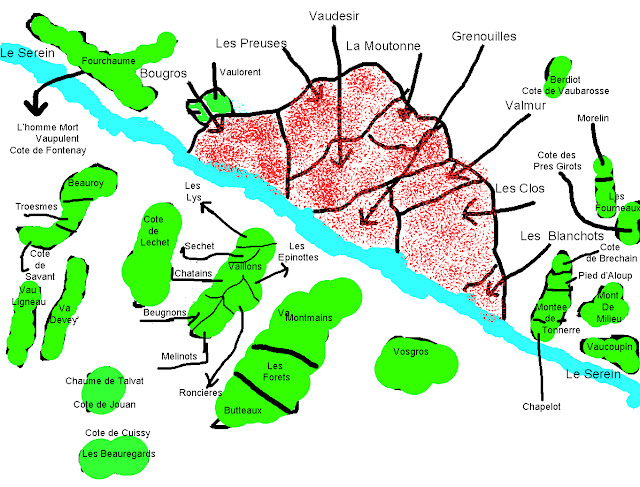Domaine de la Cras, Marc Soyard "Coteaux de Dijon"
In 2013, the city of Dijon purchased a 160-hectare agricultural property called Domaine de la Cras, located just outside the city. They decide they want to release the land to farm the vines were planted there. So they taught to create a kind of competition open to winemakers:
The criteria were:
- The vineyards had to be farmed organically.
- Had to be a young winemaker with no existing family vineyards.
- Also interested in opening the Domaine to the public for educational visits.
- The conditions that the winemaker pay a yearly “rent” of 2000 bottles per year to the city of Dijon.
Marc Soyard was chosen; a young winemaker from Jura with no family past in winemaking or background on wine.
Marc works for six years at Domaine Bizot in Vosne Romanee as chef de culture "vineyard management" also he helped Jean Yves in the cellar and was able to learn the winemaking process.
Messieurs Soyard at Domaine de la Cras as the same hands-off natural philosophy he learned at Domaine Bizot.
The vineyards are farmed organically with some biodynamic practices. All vinification is done with natural yeasts and minimal addition of sulfur. Grapes are manually harvested with sorting done at the vine. Pressed into a barrel for native yeast fermentation.
Depending on the vintage, the reds are aging in a partial whole cluster or 100% whole clusters. Elevage is traditional in a mix of new and used barrels, with frequent experimentation using different types of wood in small amounts including the traditional oak from various forests, as well as chestnut and acacia barrels. The official appellation at the Domaine is Bourgogne AOC, but the Domaine de la Cras is the sole producer allowed to use of the designation "Coteaux de Dijon".
The Domaine de la Cras produces two reds and two whites. The cuvée “Coteaux” comes from
the lower elevation vineyards, while the cuvée “Cras” a monopole comes from the steeper, better exposed vineyards and has a longer elevage.
All the wines display a true sense of place with respect of the two cepage Chardonnay and Pinot Noir.
2017 has delivered a generous Burgundy vintage, after seven years of crops shrunk by hail, frost, rot and irregular weather,
The Coteaux de Dijon 2017 by Marc Soyard at Domaine de la Cras show a quite rich golden color with youth green flash toward the rim. For the nose, the wine is a moderate-intense of aromatics. Organic and inorganic earth components with green herbs as sage and thyme also a floral component of white flowers. Some exotic fruit as underripe pineapple and notes of soil minerality as wet stone and oyster shell. Nutty element and a hint of oxidative characteristic with a layer of savory. The Palate is energetic with a rich profile and a nice permanent long finish for a simple Bourgogne Blanc. Sourced from 2.5Ha on the lower slopes of the monopole. 20-year-old vines grown in clay-limestone with marl beneath. Elevage for 10-12 months in neutral oak. Light fining before being bottled. Unfined and unfiltered.
The Bourgogne Rouge 2017
coming from vines planted between 1983 and 2001 on limestone soil. Semi Carbonic maceration for 100% whole cluster half crushed and the rest whole berries placed in the tank. No new oak.
The nose is on the black fruit spectrum with some smoky element along savory organic hints as dry rocks charcoal. The palate is very savory with fresh black cherry and crunchy plum notes. A little short on the finish but this wine is only 11,5% alcohol an outstanding drinkability without let you feel the alcohol in the body.
The 2016 vintage was a little bit more difficult due frost in spring and some mildew problem. However, thanks to a mild winter and a good ripening before harvest was regarded as a stellar vintage in terms of quality. Considering the less fruit produce price are very high.
The Monopole La Cras Chardonnay 2016
is a selection of the best-exposed vines planted in 1985 on the upper slope from only a 0.5 hectares. The Parcel name is Le Grand Bessy on limestone, clay with marl subsoil. No So2 added at any stage 15 months in barrel with some new oak.
Gold color with a watery rim, good extraction with a nice viscosity and a moderate plus intensity. Nose quite powerful with elegance oaky elements as a sweet spice and a touch of vanilla, all closed with organic minerality stony salty rocks, along with inorganic element as mushroom and nice Mediterranean herbs. The palate is dry with more tart fruit and savoriness Quince fruit, subtle tropical with the presence of spicy element. The body of the wine is solid with moderate alcohol content, acid is a moderate plus with no presence of wood tannins, new oak a very well integrated. Nice long finish and truly elegant with a good finesse structure.
2016 Monopole La Cras, is 0,5 hectares on the best exposed of the hill Le Grand Bessy. Soil for the Pinot Noir is mainly clay-limestone. Fermentation is whole bunch with regular punch downs. 40% New oak for 18 months, no racking fine or filtration, just a little So2 added at the bottling.
Color.
Medium plus intensity Ruby with a purple edge towards the rim. Good viscosity not showing high alcohol, in fact, is 12,5%.
Nose is complex with berry dark fruit cherry and plum along red skin apple, an undertone of a smoky and charcoal element. The oak perception is seen (smelled) as a container not pronounced on the nose mainly cardamon, ginger, and green curry. Organic mineral again shows the soil in the nose as stony flinty gravity limestone. Fruit aromas are an interesting combination of both tart and ripe with this other complexity element make very fascinating to smell it.
The palate is savory, vigorous energy with lots of complexity and a good combination with oak element organic minerality and complex body with and long finish in the palate.
Photos of the cellar take from the blog
Blog
--------------------------------------
wine / spirit / lambic / drinker








Comments
Post a Comment